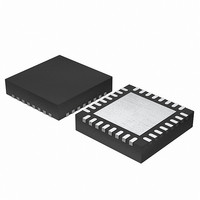EFM32G200F16 Energy Micro, EFM32G200F16 Datasheet - Page 257

EFM32G200F16
Manufacturer Part Number
EFM32G200F16
Description
MCU 32BIT 16KB FLASH 32-QFN
Manufacturer
Energy Micro
Series
Geckor
Datasheets
1.EFM32G200F16.pdf
(63 pages)
2.EFM32G200F16.pdf
(10 pages)
3.EFM32G200F16.pdf
(463 pages)
4.EFM32G200F16.pdf
(136 pages)
Specifications of EFM32G200F16
Core Processor
ARM® Cortex-M3™
Core Size
32-Bit
Speed
32MHz
Connectivity
EBI/EMI, I²C, IrDA, SmartCard, SPI, UART/USART
Peripherals
Brown-out Detect/Reset, DMA, POR, PWM, WDT
Number Of I /o
24
Program Memory Size
16KB (16K x 8)
Program Memory Type
FLASH
Ram Size
8K x 8
Voltage - Supply (vcc/vdd)
1.8 V ~ 3.8 V
Data Converters
A/D 4x12b, D/A 1x12b
Oscillator Type
External
Operating Temperature
-40°C ~ 85°C
Package / Case
32-VQFN Exposed Pad
Processor Series
EFM32G200
Core
ARM Cortex-M3
Data Bus Width
32 bit
Data Ram Size
8 KB
Interface Type
I2C, UART
Maximum Clock Frequency
32 MHz
Number Of Programmable I/os
24
Number Of Timers
2
Operating Supply Voltage
1.8 V to 3.8 V
Maximum Operating Temperature
+ 85 C
Mounting Style
SMD/SMT
Minimum Operating Temperature
- 40 C
Lead Free Status / RoHS Status
Lead free / RoHS Compliant
Eeprom Size
-
Lead Free Status / Rohs Status
Details
- EFM32G200F16 PDF datasheet
- EFM32G200F16 PDF datasheet #2
- EFM32G200F16 PDF datasheet #3
- EFM32G200F16 PDF datasheet #4
- Current page: 257 of 463
- Download datasheet (8Mb)
19.3.3.4 Configuration Lock
19.3.4 Debug Mode
19.3.5 Interrupts, DMA and PRS Output
19.3.6 GPIO Input/Output
2010-09-06 - d0001_Rev1.00
TIMER0_DTCTRL. If more bits are still set in DTFS when the automatic startup functionality has cleared
the debugger bit, the DTI module does not exit the fault state. The fault state is only exited when all the
bits in TIMER0_DTFS have been cleared.
To prevent software errors from making changes to the DTI configuration, a configuration lock is
available. Writing any value but 0xCE80 to LOCKKEY in TIMER0_DTLOCK results in TIMER0_DTFC,
TIMER0_DTCTRL, TIMER0_DTTIME and TIMER0_ROUTE being locked for writing. To unlock the
registers, write 0xCE80 to LOCKKEY inTIMER0_DTLOCK. The value of TIMER0_DTLOCK is 1 when
the lock is active, and 0 when the registers are unlocked.
When the CPU is halted in debug mode, the Timer can be configured to either continue to run or to be
frozen. This is configured in DBGHALT in TIMERn_CTRL.
The Timer has 5 output events:
• Counter Underflow
• Counter Overflow
• Compare match or input capture (one per Compare/Capture channel)
Each of the events has its own interrupt flag. Also, there is one interrupt flag for each Compare/Capture
channel which is set on buffer overflow in capture mode. Buffer overflow happens when a new capture
pushes an old unread capture out of the TIMERn_CCx_CCV/TIMERn_CCx_CCVB register pair.
If the interrupt flags are set and the corresponding interrupt enable bits in TIMERn_IEN) are set high,
the Timer will send out an interrupt request. Each of the events will also lead to a one HFPERCLK
cycle high pulse on individual PRS outputs.
Each of the events will also set a DMA request when they occur. The different DMA requests are cleared
when certain acknowledge conditions are met, see Table 19.3 (p. 257) . If DMACLRACT is set in
TIMERn_CTRL, the DMA request is cleared when the triggered DMA channel is active, without having
to access any timer registers.
Table 19.3. TIMER Events
The TIMn_CCx inputs/outputs and TIM0_CDTIx outputs are accessible as alternate functions through
GPIO. Each pin connection can be enabled/disabled separately by setting the corresponding CCxPEN
or CDTIxPEN bits in TIMERn_ROUTE. The LOCATION bits in the same register can be used to move
all enabled pins to alternate pins.
Underflow/Overflow
CC 0
CC 1
CC 2
Event
...the world's most energy friendly microcontrollers
257
Read or write to TIMERn_CNT or TIMERn_TOPB
Read or write to TIMERn_CC0_CCV or
TIMERn_CC0_CCVB
Read or write to TIMERn_CC1_CCV or
TIMERn_CC1_CCVB
Read or write to TIMERn_CC2_CCV or
TIMERn_CC2_CCVB
Acknowledge
www.energymicro.com
TIMERn
Related parts for EFM32G200F16
Image
Part Number
Description
Manufacturer
Datasheet
Request
R

Part Number:
Description:
KIT STARTER EFM32 GECKO
Manufacturer:
Energy Micro
Datasheet:

Part Number:
Description:
KIT DEV EFM32 GECKO LCD SUPPORT
Manufacturer:
Energy Micro
Datasheet:

Part Number:
Description:
BOARD PROTOTYPING FOR EFM32
Manufacturer:
Energy Micro
Datasheet:

Part Number:
Description:
KIT DEVELOPMENT EFM32 GECKO
Manufacturer:
Energy Micro
Datasheet:

Part Number:
Description:
MCU, MPU & DSP Development Tools TG840 Sample Kit
Manufacturer:
Energy Micro
Datasheet:

Part Number:
Description:
MCU, MPU & DSP Development Tools TG Starter Kit
Manufacturer:
Energy Micro
Datasheet:

Part Number:
Description:
MCU, MPU & DSP Development Tools TG108 Sample Kit
Manufacturer:
Energy Micro

Part Number:
Description:
MCU, MPU & DSP Development Tools TG210 Sample Kit
Manufacturer:
Energy Micro
Datasheet:

Part Number:
Description:
MCU, MPU & DSP Development Tools TG822 Sample Kit
Manufacturer:
Energy Micro
Datasheet:

Part Number:
Description:
MCU, MPU & DSP Development Tools TG230 Sample Kit
Manufacturer:
Energy Micro

Part Number:
Description:
SAMPLE KIT (SMALL BOX - CONTAINING 2 DEVICES)
Manufacturer:
Energy Micro

Part Number:
Description:
SAMPLE KIT (SMALL BOX - CONTAINING 2 DEVICES)
Manufacturer:
Energy Micro










